On In a Station of the Metro
- 格式:docx
- 大小:21.38 KB
- 文档页数:3
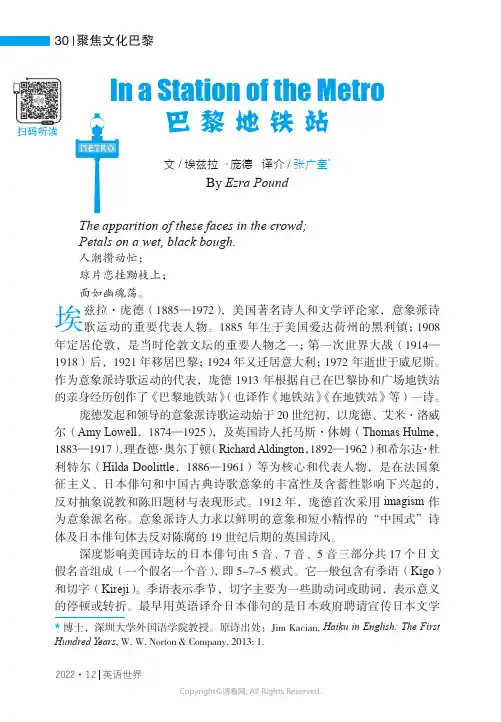
The apparition of these faces in the crowd; Petals on a wet, black bough. 人潮攒动忙;琼片恋挂黝枝上;面如幽魂荡。
埃兹拉·庞德(1885—1972)歌运动的重要代表人物。
1885 年定居伦敦,是当时伦敦文坛的重要人物之一;1918)后,1921作为意象派诗歌运动的代表,庞德 1913 年根据自己在巴黎协和广场地铁站的亲身经历创作了《巴黎地铁站》庞德发起和领导的意象派诗歌运动始于尔(Amy Lowell 1883—1917)、利特尔(Hilda Doolittle 征主义、日本俳句和中国古典诗歌意象的丰富性及含蓄性影响下兴起的,反对抽象说教和陈旧题材与表现形式。
1912In a Station of the Metro 扫码听读
英语世界2022·12。
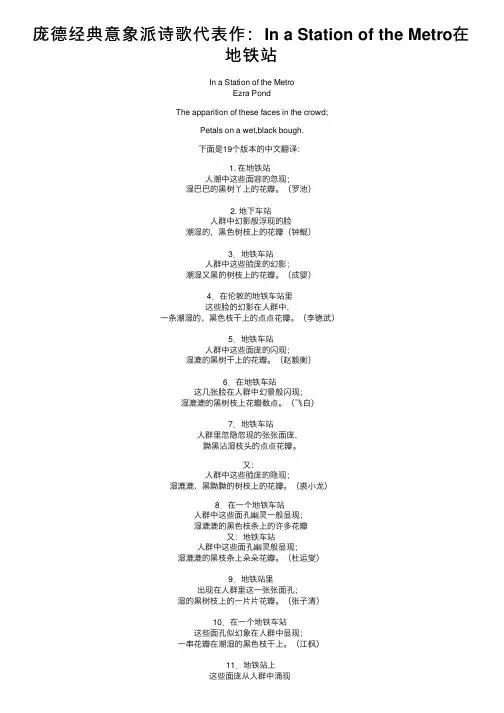
庞德经典意象派诗歌代表作:In a Station of the Metro在地铁站In a Station of the MetroEzra PondThe apparition of these faces in the crowd;Petals on a wet,black bough.下⾯是19个版本的中⽂翻译:1. 在地铁站⼈潮中这些⾯容的忽现;湿巴巴的⿊树丫上的花瓣。
(罗池)2. 地下车站⼈群中幻影般浮现的脸潮湿的,⿊⾊树枝上的花瓣(钟鲲)3.地铁车站⼈群中这些脸庞的幻影;潮湿⼜⿊的树枝上的花瓣。
(成婴)4.在伦敦的地铁车站⾥这些脸的幻影在⼈群中,⼀条潮湿的、⿊⾊枝⼲上的点点花瓣。
(李德武)5.地铁车站⼈群中这些⾯庞的闪现;湿漉的⿊树⼲上的花瓣。
(赵毅衡)6.在地铁车站这⼏张脸在⼈群中幻景般闪现;湿漉漉的⿊树枝上花瓣数点。
(飞⽩)7.地铁车站⼈群⾥忽隐忽现的张张⾯庞,黝⿊沾湿枝头的点点花瓣。
⼜:⼈群中这些脸庞的隐现;湿漉漉、⿊黝黝的树枝上的花瓣。
(裘⼩龙)8.在⼀个地铁车站⼈群中这些⾯孔幽灵⼀般显现;湿漉漉的⿊⾊枝条上的许多花瓣⼜:地铁车站⼈群中这些⾯孔幽灵般显现;湿漉漉的⿊枝条上朵朵花瓣。
(杜运燮)9.地铁站⾥出现在⼈群⾥这⼀张张⾯孔;湿的⿊树枝上的⼀⽚⽚花瓣。
(张⼦清)10.在⼀个地铁车站这些⾯孔似幻象在⼈群中显现;⼀串花瓣在潮湿的⿊⾊枝⼲上。
(江枫)11.地铁站上这些⾯庞从⼈群中涌现湿漉漉的⿊树⼲上花瓣朵朵(郑敏)12. ⼈群⾥这些脸忽然闪现;花丛在⼀条湿⿊的树枝。
(流沙河)13. ⼈群中,这些⾯孔的⿁影;潮湿的⿊树枝上的花瓣。
(余光中)14. ⼈群中千张脸空的魅影;⼀条湿⽽⿊的树枝上的花瓣。
(洛夫)15. 这些⾯孔浮现于⼈群;花瓣潮湿的⿊树枝(颜元叔)16. 在群众中这些脸的魅影;花瓣在⼀根濡湿的辚树丫上(李英豪)17. 在这拥挤的⼈群⾥这个美貌的突现;⼀如花瓣在潮湿⾥,如暗淡的树枝(周伯乃)18. ⼈群中⼀张张魅影的脸孔湿黝枝⼲上⽚⽚花瓣 (张错)19. 在地铁车站⼈流中忽隐忽现的张张脸庞;黝⿊沾湿的枝头上⽚⽚花瓣。
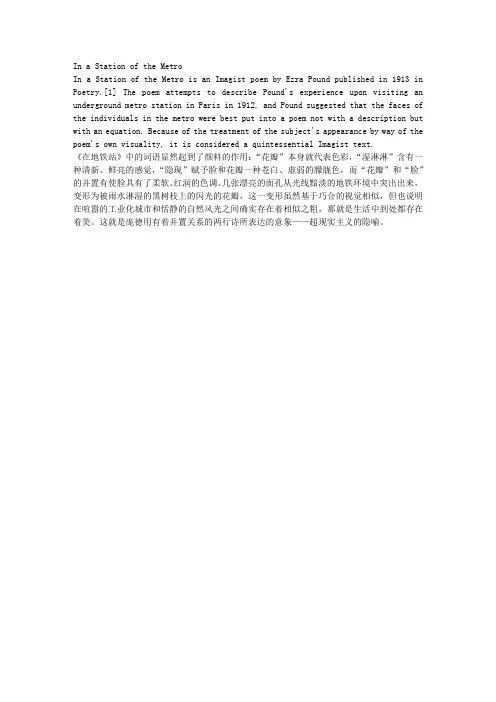
In a Station of the Metro
In a Station of the Metro is an Imagist poem by Ezra Pound published in 1913 in Poetry.[1] The poem attempts to describe Pound's experience upon visiting an underground metro station in Paris in 1912, and Pound suggested that the faces of the individuals in the metro were best put into a poem not with a description but with an equation. Because of the treatment of the subject's appearance by way of the poem's own visuality, it is considered a quintessential Imagist text.
《在地铁站》中的词语显然起到了颜料的作用:“花瓣”本身就代表色彩,“湿淋淋”含有一种清新、鲜亮的感觉,“隐现”赋予脸和花瓣一种苍白、虚弱的朦胧色,而“花瓣”和“脸”的并置有使脸具有了柔软、红润的色调。
几张漂亮的面孔从光线黯淡的地铁环境中突出出来,变形为被雨水淋湿的黑树枝上的闪光的花瓣,这一变形虽然基于巧合的视觉相似,但也说明在喧嚣的工业化城市和恬静的自然风光之间确实存在着相似之粗,那就是生活中到处都存在着美。
这就是庞德用有着并置关系的两行诗所表达的意象——超现实主义的隐喻。
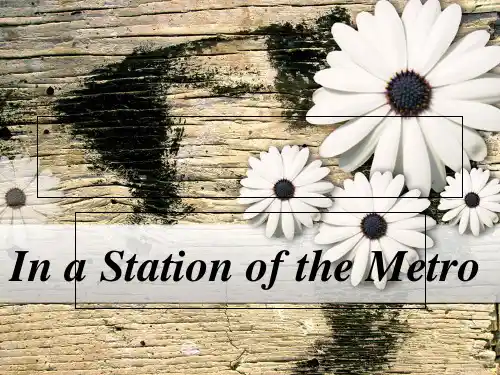
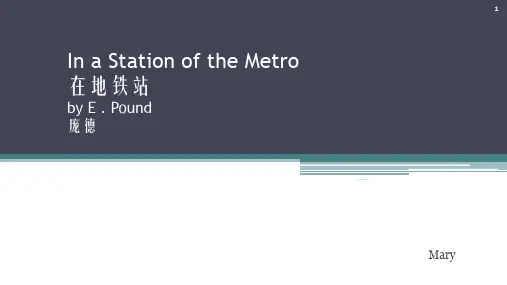
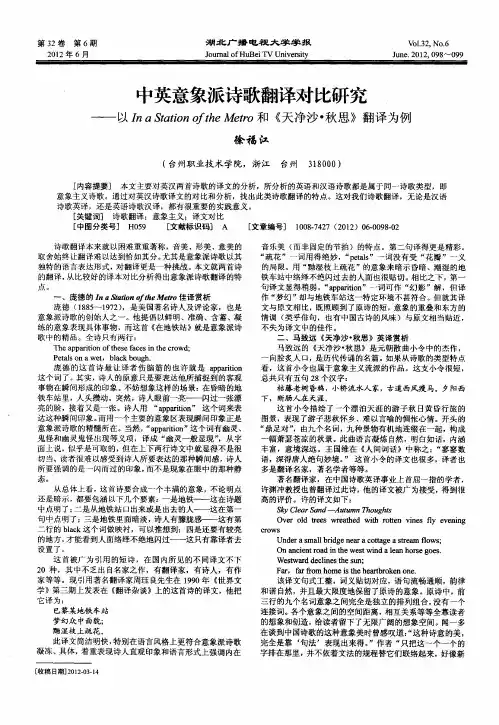
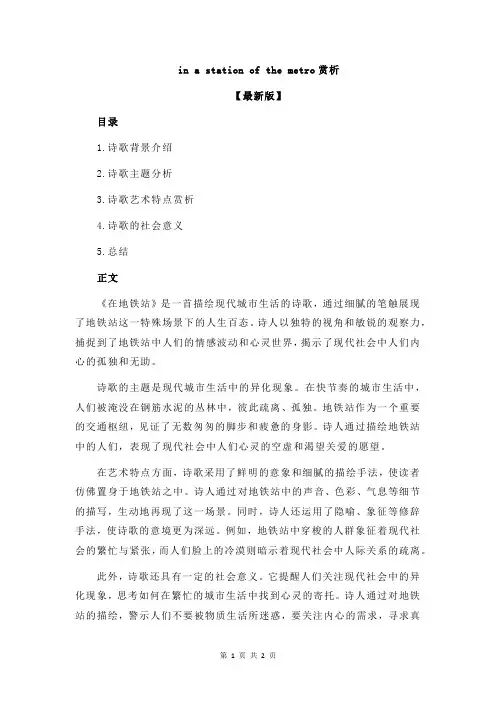
in a station of the metro赏析
【最新版】
目录
1.诗歌背景介绍
2.诗歌主题分析
3.诗歌艺术特点赏析
4.诗歌的社会意义
5.总结
正文
《在地铁站》是一首描绘现代城市生活的诗歌,通过细腻的笔触展现了地铁站这一特殊场景下的人生百态。
诗人以独特的视角和敏锐的观察力,捕捉到了地铁站中人们的情感波动和心灵世界,揭示了现代社会中人们内心的孤独和无助。
诗歌的主题是现代城市生活中的异化现象。
在快节奏的城市生活中,人们被淹没在钢筋水泥的丛林中,彼此疏离、孤独。
地铁站作为一个重要的交通枢纽,见证了无数匆匆的脚步和疲惫的身影。
诗人通过描绘地铁站中的人们,表现了现代社会中人们心灵的空虚和渴望关爱的愿望。
在艺术特点方面,诗歌采用了鲜明的意象和细腻的描绘手法,使读者仿佛置身于地铁站之中。
诗人通过对地铁站中的声音、色彩、气息等细节的描写,生动地再现了这一场景。
同时,诗人还运用了隐喻、象征等修辞手法,使诗歌的意境更为深远。
例如,地铁站中穿梭的人群象征着现代社会的繁忙与紧张,而人们脸上的冷漠则暗示着现代社会中人际关系的疏离。
此外,诗歌还具有一定的社会意义。
它提醒人们关注现代社会中的异化现象,思考如何在繁忙的城市生活中找到心灵的寄托。
诗人通过对地铁站的描绘,警示人们不要被物质生活所迷惑,要关注内心的需求,寻求真
正的幸福。
总之,《在地铁站》是一首以地铁站为背景,描绘现代城市生活,反映人们心灵世界的诗歌。
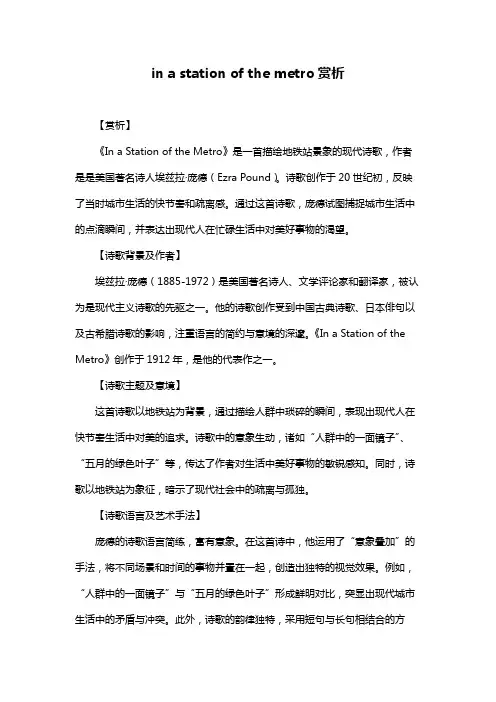
in a station of the metro赏析【赏析】《In a Station of the Metro》是一首描绘地铁站景象的现代诗歌,作者是是美国著名诗人埃兹拉·庞德(Ezra Pound)。
诗歌创作于20世纪初,反映了当时城市生活的快节奏和疏离感。
通过这首诗歌,庞德试图捕捉城市生活中的点滴瞬间,并表达出现代人在忙碌生活中对美好事物的渴望。
【诗歌背景及作者】埃兹拉·庞德(1885-1972)是美国著名诗人、文学评论家和翻译家,被认为是现代主义诗歌的先驱之一。
他的诗歌创作受到中国古典诗歌、日本俳句以及古希腊诗歌的影响,注重语言的简约与意境的深邃。
《In a Station of the Metro》创作于1912年,是他的代表作之一。
【诗歌主题及意境】这首诗歌以地铁站为背景,通过描绘人群中琐碎的瞬间,表现出现代人在快节奏生活中对美的追求。
诗歌中的意象生动,诸如“人群中的一面镜子”、“五月的绿色叶子”等,传达了作者对生活中美好事物的敏锐感知。
同时,诗歌以地铁站为象征,暗示了现代社会中的疏离与孤独。
【诗歌语言及艺术手法】庞德的诗歌语言简练,富有意象。
在这首诗中,他运用了“意象叠加”的手法,将不同场景和时间的事物并置在一起,创造出独特的视觉效果。
例如,“人群中的一面镜子”与“五月的绿色叶子”形成鲜明对比,突显出现代城市生活中的矛盾与冲突。
此外,诗歌的韵律独特,采用短句与长句相结合的方式,呈现出地铁站拥挤与繁忙的氛围。
【诗歌的价值和启示】《In a Station of the Metro》以独特的视角审视了现代城市生活,为我们提供了一个思考城市人与自然、快节奏与宁静之间关系的窗口。
诗歌传达了作者对美好生活的向往,提醒人们在忙碌的生活中关注身边的美好事物。
同时,这首诗歌也是现代主义诗歌的代表之作,对后世诗人产生了深远影响。
通过分析这首诗歌,我们可以看到庞德在诗歌创作中的独特艺术手法和审美观念。
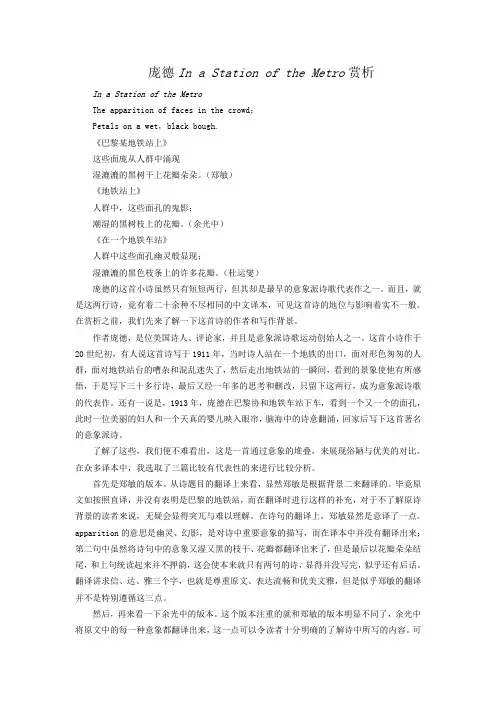
庞德In a Station of the Metro赏析In a Station of the MetroThe apparition of faces in the crowd;Petals on a wet,black bough.《巴黎某地铁站上》这些面庞从人群中涌现湿漉漉的黑树干上花瓣朵朵。
(郑敏)《地铁站上》人群中,这些面孔的鬼影;潮湿的黑树枝上的花瓣。
(余光中)《在一个地铁车站》人群中这些面孔幽灵般显现;湿漉漉的黑色枝条上的许多花瓣。
(杜运燮)庞德的这首小诗虽然只有短短两行,但其却是最早的意象派诗歌代表作之一。
而且,就是这两行诗,竟有着二十余种不尽相同的中文译本,可见这首诗的地位与影响着实不一般。
在赏析之前,我们先来了解一下这首诗的作者和写作背景。
作者庞德,是位美国诗人、评论家,并且是意象派诗歌运动创始人之一。
这首小诗作于20世纪初,有人说这首诗写于1911年,当时诗人站在一个地铁的出口,面对形色匆匆的人群,面对地铁站台的嘈杂和混乱迷失了,然后走出地铁站的一瞬间,看到的景象使他有所感悟,于是写下三十多行诗,最后又经一年多的思考和删改,只留下这两行,成为意象派诗歌的代表作。
还有一说是,1913年,庞德在巴黎协和地铁车站下车,看到一个又一个的面孔,此时一位美丽的妇人和一个天真的婴儿映入眼帘,脑海中的诗意翻涌,回家后写下这首著名的意象派诗。
了解了这些,我们便不难看出,这是一首通过意象的堆叠,来展现俗陋与优美的对比。
在众多译本中,我选取了三篇比较有代表性的来进行比较分析。
首先是郑敏的版本。
从诗题目的翻译上来看,显然郑敏是根据背景二来翻译的。
毕竟原文如按照直译,并没有表明是巴黎的地铁站,而在翻译时进行这样的补充,对于不了解原诗背景的读者来说,无疑会显得突兀与难以理解。
在诗句的翻译上,郑敏显然是意译了一点。
apparition的意思是幽灵、幻影,是对诗中重要意象的描写,而在译本中并没有翻译出来;第二句中虽然将诗句中的意象又湿又黑的枝干、花瓣都翻译出来了,但是最后以花瓣朵朵结尾,和上句统读起来并不押韵,这会使本来就只有两句的诗,显得并没写完,似乎还有后话。
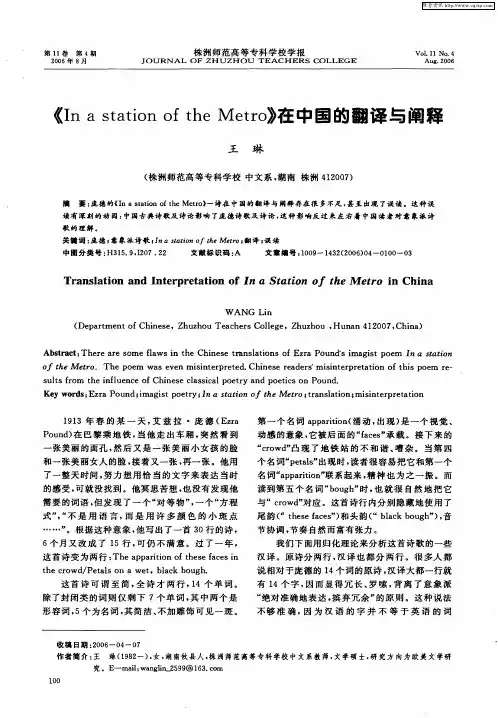
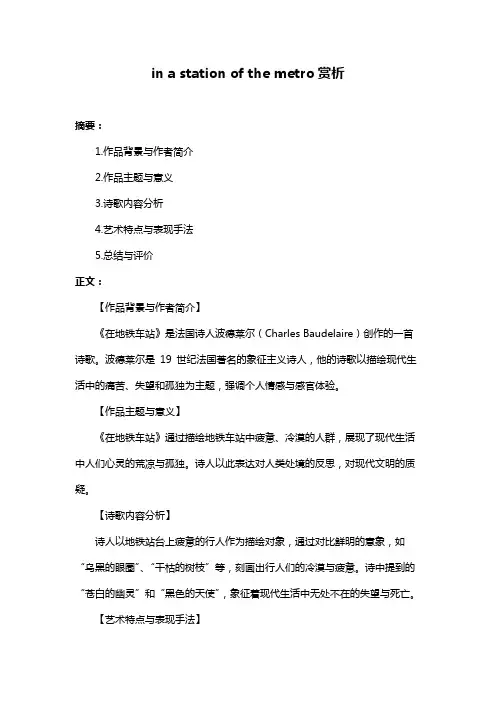
in a station of the metro赏析
摘要:
1.作品背景与作者简介
2.作品主题与意义
3.诗歌内容分析
4.艺术特点与表现手法
5.总结与评价
正文:
【作品背景与作者简介】
《在地铁车站》是法国诗人波德莱尔(Charles Baudelaire)创作的一首诗歌。
波德莱尔是19 世纪法国著名的象征主义诗人,他的诗歌以描绘现代生活中的痛苦、失望和孤独为主题,强调个人情感与感官体验。
【作品主题与意义】
《在地铁车站》通过描绘地铁车站中疲惫、冷漠的人群,展现了现代生活中人们心灵的荒凉与孤独。
诗人以此表达对人类处境的反思,对现代文明的质疑。
【诗歌内容分析】
诗人以地铁站台上疲惫的行人作为描绘对象,通过对比鲜明的意象,如“乌黑的眼圈”、“干枯的树枝”等,刻画出行人们的冷漠与疲惫。
诗中提到的“苍白的幽灵”和“黑色的天使”,象征着现代生活中无处不在的失望与死亡。
【艺术特点与表现手法】
波德莱尔在诗歌中运用了大量象征意象,如“乌黑的眼圈”、“干枯的树枝”等,既增强了诗歌的艺术表现力,又深化了诗歌的主题。
此外,诗人在诗歌中采用第二人称叙述,使诗歌更具亲近感,更能引起读者的共鸣。
【总结与评价】
《在地铁车站》作为波德莱尔的代表作之一,以其独特的艺术表现手法和深刻的主题,成为19 世纪法国诗歌的经典之作。
诗人通过对现代生活中人们心灵荒凉的描绘,对人类处境进行了深刻的反思,对现代文明提出了质疑。
仿写inthestationofthemetro摘要:一、地铁车站的独特氛围二、地铁站内的各种景观三、地铁车站与城市生活的紧密联系四、地铁车站的发展与未来正文:一、地铁车站的独特氛围地铁车站,作为城市交通的重要枢纽,拥有着独特的氛围。
在这里,人们行色匆匆,脚步从未停歇。
无论是早晨的上班族,还是晚上的夜归人,都在这个空间中交汇、流动。
独特的车站设计,以及繁忙的人流,让这里成为了一个充满活力与生机的地方。
二、地铁站内的各种景观地铁站内,有着各种各样的景观。
首先,是地铁站的建筑设计。
每一座地铁站都有其独特的风格,或现代、或古典,或艺术、或科技。
这些设计元素,让地铁站成为了一个充满魅力的空间。
其次,是地铁站内的广告。
这些广告,既有商业广告,也有公益广告,他们以其丰富的形式和内容,为地铁站增添了浓厚的文化气息。
最后,是地铁站内的乘客。
他们来自不同的地方,有着不同的目的,但他们都在这里交汇、交流,让地铁站成为了一个充满故事的地方。
三、地铁车站与城市生活的紧密联系地铁车站与城市生活紧密相连。
首先,地铁车站是城市交通的重要节点,承担着大量的运输任务,保障了城市生活的正常运行。
其次,地铁车站也是城市生活的重要部分,许多人的生活都离不开地铁车站。
他们每天在这里出发,也在这里结束一天的忙碌。
地铁车站,已经成为了城市生活的重要象征。
四、地铁车站的发展与未来随着我国城市化进程的加速,地铁车站的发展也日益迅速。
新的地铁线路在不断规划,新的地铁车站在不断建设。
未来,地铁车站将更加便捷,更加智能化。
我们可以期待,未来的地铁车站,将会成为一个更加舒适、更加人性化的空间。
总的来说,地铁车站是城市生活的重要组成部分,也是城市发展的重要标志。
它的发展,不仅体现了我国城市化进程的速度,也体现了我国城市化进程的质量。
仿写inthestationofthemetro
(实用版)
目录
1.介绍地铁车站的常见景象
2.描述地铁站内人们的行为和心理状态
3.表达对地铁车站的感慨和思考
正文
在地铁车站,我们常常可以看到熙熙攘攘的人群,拥挤的站台,以及人们脸上不同的表情。
这里,有匆忙的行人,有焦急的乘客,还有悠闲的游客。
无论是哪种人,他们都有一个共同点,那就是在这个地下世界中寻找自己的目的地。
地铁站内,人们或站或坐,或走或停,每个人都在进行着自己的活动。
有些人拿着手机玩游戏,有些人在看书或者报纸,还有些人在发呆或者沉思。
他们的行为虽然各不相同,但都可以感受到一种共同的心理状态:等待。
等待车的到来,等待到达目的地,等待生活的改变。
站在地铁车站,我不禁感慨万千。
这是一个充满活力和机会的城市,每个人都在这里寻找自己的梦想和未来。
然而,这也是一个充满压力和挑战的地方,每个人都需要面对生活的种种困难和挑战。
地铁车站,就像是城市的一个缩影,它反映了城市的繁华和忙碌,也反映了人们的生活状态和心理状态。
在这里,我们可以看到生活的多样性和复杂性,也可以看到人们的坚韧和勇气。
无论是谁,我们都在这个地铁车站中,寻找着自己的目的地,等待着生活的改变。
在这个过程中,我们需要有勇气去面对挑战,有耐心去等待机会,有决心去追求梦想。
第1页共1页。
My Comment on “In a Station of the Metro” (1913) by Ezra PoundI wa s thund eri ng ly s hoc ke d b y this poe m a t the fi rs t si te whe n I re ad i t, a nd I e ve n k no w a nythi ng a bo ut wha t i t doe s wa nt to e xp re ss. It is s o s ho rt tha t co ntai ns o nly 14 wo rds i n 2 li nes o f 1 se nte nc e i n a ll. Ho we ve r, afte r rea di ng i t fo r co untle ss times I fi nd so me thi ng o ut o f my e xp ec ta tio n.The p oe m is es se nti a lly a se t o f i ma ge s tha t ha ve une xpec ted li ke nes s a nd co nve y the ra re e mo ti o n tha t P o und was e xp eri e nci ng a t tha t ti me.“The app a ri tio n o f thes e fa ces i n the cro wd; Pe ta ls o n a we t, b lac k bo ug h.” F ro m the po em, we c a n ca tc h thi ngs lik e ap pa ri tio n, face s, c ro wd, pe ta ls, a nd b la ck bo ug h. Spe ci fica lly, the fi rs t li ne i s a dep ic tio n o f the s ub wa y s ta ti o n. "Appa ri tio n "is the ke y wo rd whic h b ri ng s a g ho s tly, vi sio na ry atmo sp he re. In the s eco nd li ne, pe ta ls a re a n i mag e fo r tho se bea uti ful fa ce s, fo r the re i s a s e nse o f bea uty i n the m. Ye t "a we t, blac k b o ug h" whic h s e ts o ff "p eta ls" c rea te s a g hos tly, mys te rio us a ura. Thus, i t ec hoe s the mo od o f the fi rs t li ne. Thi s s hort p oe m jus ti fie s Po und's c apa bi li ty o f ha nd li ng va rio us imag es simulta ne o us ly.In P o nd's p oe m In a Sta ti o n o f the Metro, the fac e is so lo ve ly tha t loo ks li ke a wa te ry pea r flo we r. Thi s is i ma go whi c h des c rib es the fig ures, la nd sca pe s o r i ntra pe rs o na l fee li ng s a s the mi s ty bea uty. It is so lo ve ly a i mago tha t ma kes yo u d ro p i n dee p a nd re luc ta nt to co me ba ck to rea li ty.Po und co ntras ts the fac tua l, munda ne i mag e tha t he ac tua lly wi tnes sed wi th a me ta p hor fro m na ture a nd thus i nfus es this “app a riti o n” wi th vi s ua l b ea uty. The re is a q ui ck tra nsi ti o n fro m the sta te me nt o f the fi rst li ne to the sec o nd li ne‟s vi vid metap ho r; thi s…s upe r-p osi to ry‟ tec hniq ue e xe mp li fi es the Jap a ne se h aiku s tyle. Wha t‟s mo re, the wo rd “a ppa ri tio n” i s c o nside red c rucia l as i t e voke s a mys tic a l a nd s up erna tura l se nse of i mp reci sio n whi c h i s the n rei nfo rc ed b y the me ta p ho r o f the se co nd li ne. The p losi ve wo rd…Pe ta ls‟ c o njures idea s o f de li ca te, femi ni ne be a uty whic h co ntras ts wi th the blea k ne ss of the …we t, b lac k b o ug h‟.The po e m i s co nsid e red o ne o f the le adi ng po ems o f the Imagi s t tradi ti o n. Wri tte n i n a Japa ne se haik u s tyle, P o und‟s proce ss of de le ti o n fro m thi rty li nes to o nly fo urtee n wo rd s typi fi es Imagi s m‟s foc us o n ec o no my o f la ng ua ge, p re cisio n o f i mag e ry a nd e xp eri me nti ng wi th no n-tradi ti o na l ve rs e fo rms.I wa s a ttra c te d b y this po em be ca use it ca n a ro us e my me mo ri es o f the sa me e xpe rie nce. So me ti me s whe n we a re amo ng ma ny p eop le i n the c ro wed sta tio n, o ne o r two b ea uti es o re ve n s o me thi ng ti ny ca n b ri ng us i nto di ffe re nt si tua tio n. Be sid es, I p re fe r the wa y i n whic h P o und wri te thi s po em, a nd I ca nno t ag ree wi th hi m mo re.The o rigi na l p oe m, re se mb li ng a n Ea s te rn H aik u, s epa ra ted the two li nes wi th a co lo n, i n k eep i ng wi th o the r i magi s tic po e ms whi c h Po und wrote a t the ti me. Co mp li a nt wi th tradi tio na l h aik us Po und bo th co njure s a n i mage whic h co ntai ns ca re ful re fe re nc e to lo ca ti o n a nd e xp re sse s a wa ve o f emo tio n wi tho ut the us e o f abs tra c t i dea s. The te mpo o f the p oe m s lo ws do wn a t two dis ti nc t mo me nts, “these fac es” i n the fi rs t li ne a nd the “we t, b lac k p eta ls” at the e nd o f the sec o nd li ne; thi s no t o nly a dd s e mp ha sis to the spac es i n be twee n the words b ut e nco urag es the rea de r to re s t a mo me nt o n the c o njured i mag es. Stro ng ass o na nc e gi ve s the poe m a d is ti nc t ro und, na tura l fee l.In le a vi ng hi s rea de r a lo ne i n the s eco nd s e nte nc e Po und gi ve s the m ti me to d we ll o n the true ju xtap osi tio n o f the i mag es i n their e nti re ty. Ca re fully co ns tructi ng the two imag es s o tha t the y themse lve s b eco me a ppa ri tio ns be fo re us, Po und e nab les the re ade r to di s to rt b o th sce ne s. The y the n be co me pe rso na li zed ima ges i n whi c h the re ade r ca n imagi ne hi m or he rs e lf p re se nt i n bo th, s ti rri ng the co ntras ti ng e mo ti o ns wi thi n thei r mi nd s. B y placi ng hi ms e lf i n the me tro sta tio n P o und na rra te s the p oe m wi tho ut i mp osi ng too muc h o n the rea de r. Gui di ng us fro m the fi rs t idea to the sec o nd, P o und‟s i nte ntio n wa s no t to si t b o th imag es alo ngsid e o ne a no the r, b ut to a llo w o ne i ma ge to be tra ns formed into a no ther b y wha t Wi lla rd Bo hn re fers to as a“s udd e n me ta mo rp ho sis”.All i n a ll, “In a Sta tio n o f the Me tro” (1913) b y E zra Po und wa s s uc h a wo nde rful work tha t I a pp re cia te ve ry muc h.09英教4班梁彩蓉2009154409。
在地铁站内》庞德最著名的作品,要属意象派名作《在地铁站内》:
In a Station of the Metro
The apparition of these faces in the crowd;
Petals on a wet, black bough.
这几张脸在人群中幻景般闪现;
湿漉漉的黑树枝上花瓣数点。
《在地铁站内》仅两行、14个字,是一首单一意象诗(one-image poem)。
它是庞德根据在巴黎协和广场地铁站的印象写成的。
诗虽短,但诗人最后落笔定稿前经过相当一段时间的酝酿和推敲。
在地铁站庞德眼前闪过一张张美丽的脸。
在归途中,这些脸在他眼前反埃兹拉·庞德
复出现,直到最后他们逐渐变成了一片片彩色印花色底。
这时他产生了一个念头,要作出一幅纯粹表现色彩的斑斑点点的非写实主义的画,但他不会作画,只能以诗代之。
诗的两行互相依存。
apparition是幻象、幽灵,使人们联想到来来往往的乘客的一张张脸。
第二行的petal 花瓣则传递了美的信息。
这一信息由于有深色而又带湿气的树枝的反衬而变得突出鲜明了,同时也给人以模糊重叠之感,意境也就更丰满了。
此诗酷似19世纪法国印象主义画派作品,如反复诵读,读者能勾画出一幅色彩丰富的画面。
与此同时也会发现诗歌在音的处理上很巧妙。
第一行的[p]音与第二行的[p]音遥相呼应,但其中一个只构成非重读音节;两行末尾均有[au]音,只是前者有辅音[d],后者没有。
第二行中[e]音的重复等都加强了这首短诗的音乐感。
以湿润的黑色树枝上挂着的花瓣来比喻他眼前所闪现的脸反映出诗人令人折服的想象力。
in a station of the metro赏析摘要:1.作品背景介绍2.诗歌内容分析3.艺术特点概述4.作品意义阐述正文:一、作品背景介绍《In a Station of the Metro》是美国著名诗人埃兹拉·庞德创作的一首现代诗歌。
这首诗歌创作于20世纪初,是庞德意象派诗歌的代表作之一。
该作品以地铁站为背景,通过捕捉城市生活的瞬间,展现了现代都市生活的繁忙与拥挤。
二、诗歌内容分析诗歌开篇便描绘了地铁站的人流如织、喧嚣纷繁的场景,通过“面孔,一张张,模糊不清”的描写,传达了城市生活的快节奏和疏离感。
接着,诗人运用意象手法,将地铁站的人流比喻为“湿漉漉的树叶”,既形象地展现了人群的众多,又表达出城市生活的压抑与单调。
诗歌下半部分,诗人转移到对大自然的描绘,通过“阳光洒在树叶上”的生动画面,与地铁站拥挤的人群形成鲜明对比,表达了诗人对自然美的向往。
最后两句“地铁站里的面孔,树叶上的阳光”,诗人将两者巧妙地结合在一起,揭示了现代都市生活中人们渴望自然、寻求心灵慰藉的诉求。
三、艺术特点概述《In a Station of the Metro》的艺术特点主要体现在以下几个方面:1.意象手法:庞德善于捕捉生活中的细节,将平凡的事物赋予深刻的象征意义。
在这首诗歌中,他将地铁站的人流比喻为树叶,既表现了城市生活的压抑,又凸显了人们对自然的向往。
2.对比手法:诗人通过对比地铁站与大自然的景象,展现了现代都市生活与自然的矛盾冲突,使读者在强烈的反差中感受到心灵的震撼。
3.简洁明快的语言:庞德的诗歌语言简练,直接传达了诗人的情感和思想。
例如,“面孔,一张张,模糊不清”的描写,简洁地展现了地铁站的人流如织。
四、作品意义阐述《In a Station of the Metro》反映了现代都市生活的矛盾和困境,表达了人们在快节奏生活中对自然的向往和对心灵慰藉的渴望。
这首诗歌提醒我们在繁忙的都市生活中,要学会发现生活中的美好,寻求心灵的寄托,从而在紧张的氛围中找到一丝安慰。
On "In a Station of the Metro"Ezra Pound (from Gaudier-Brzeska, 1916) Three years ago in Paris I got out of a "metro" train at La Concorde, and sawsuddenly a beautiful face, and then another and another, and then a beautiful child’s face, and then another beautiful woman, and I tried all that day tofind words for what this had meant to me, and I could not find any wordsthat seemed to me worthy, or as lovely as that sudden emotion. And that evening, as I went home along the Rue Raynouard, I was still trying and I found, suddenly, the expression. I do not mean that I found words, but there came an equation . . . not in speech, but in lit tle splotches of colour. It was just that - a "pattern," or hardly a pattern, if by "pattern" you mean something with a "repeat" in it. But itwas a word, the beginning, for me, of a language in colour. I do not meanthat I was unfamiliar with the kindergarten stories about colours being liketones in music. I think that sort of thing is nonsense. If you try to make notespermanently correspond with particular colours, it is like tying narrowmeanings to symbols.That evening, in the Rue Raynouard, I realized quite vividly that if I were apainter, or if I had, often, that kind of emotion, of even if I had the energy toget paints and brushes and keep at it, I might found a new school of paintingthat would speak only by arrangements in colour.And so, when I came to read Kandinsky’s chapter on the language of formand colour, I found little that was new to me. I only felt that someone elseunderstood what I understood, and had written it out very clearly. It seemsquite natural to me that an artist should have just as much pleasure in anarrangement of planes or in a pattern of figures, as in painting portraits offine ladies, or in portraying the Mother of God as the symbolists bid us. When I find people ridiculing the new arts, or making fun of the clumsy odd terms that we use in trying to talk of them amongst ourselves; when they laugh at our talking about the "ice-block quality" in Picasso, I think it is only because they do not know what thought is like, and they are familiar only with argument and gibe and opinion. That is to say, they can only enjoy what they have been brought up to consider enjoyable, or what some essayist has talked about in mellifluous phrases. They think only "the shells of thought," as de Gourmont calls them; the thoughts that have been already thought out by othersAny mind that is worth calling a mind must have needs beyond the existing categories of language, just as a painter must have pigments or shades more numerous than the existing names of the colours.Perhaps this is enough to explain the words in my "Vortex": --"Every concept, every emotion, presents itself to the vivid consciousness in some primary form. It belongs to the art of this form."That is to say, my experience in Paris should have gone into paint. If instead of colour I had perceived sound or planes in relation, I should have expressed it in music or in sculpture. Colour was, in that instance, the "primary pigment"; I mean that it was the first adequate equation that came into consciousness. The Vorticist uses the "primary pigment." Vorticism is art before it has spread itself into flaccidity, into elaboration and secondary application.What I have said of one vorticist art can be transposed for another vorticist art. But let me go on then with my own branch of vorticism, about which I can probably speak with greater clarity. All poetic language is the language of exploration. Since the beginning of bad writing, writers have used images as ornaments. The point of Imagisme is that it does not use images as ornaments. The image is itself the speech. The image is the word beyond formulated language.I once saw a small child go to an electric light switch as say, "Mamma, can I open the light?" She was using the age-old language of exploration, the language of art. It was a sort of metaphor, but she was not using it as ornamentation.One is tired of ornamentations, they are all a trick, and any sharp person can learn them.The Japanese have had the sense of exploration. They have understood the beauty of t his sort of knowing. A Chinaman said long ago that if a man can’t say what he has to say in twelve lines he had better keep quiet. The Japanese have evolved the still shorter form of the hokku."The fallen blossom flies back to its branch:A butterfly."That is the substance of a very well-known hokku. Victor Plarr tells me that once, when he was walking over snow with a Japanese naval officer, theycame to a place where a cat had crossed the path, and the officer said," Stop, I am making a poem." Which poem was, roughly, as follows: --"The footsteps of the cat upon the snow:(are like) plum-blossoms."The words "are like" would not occur in the original, but I add them for clarity.The "one image poem" is a form of super-position, that is to say, it is one idea set on top of another. I found it useful in getting out of the impasse in which I had been left by my metro emotion. I wrote a thirty-line poem, and destroyed it because it was what we call work "of second intensity." Six months later I made a poem half that length; a year later I made the following hokku-like sentence: --"The apparition of these faces in the crowd:Petals, on a wet, black bough."I dare say it is meaningless unless one has drifted into a certain vein of thought. I a poem of this sort one is trying to record the precise instant when a thing outward and objective transforms itself, or darts into a thing inward and subjective.。